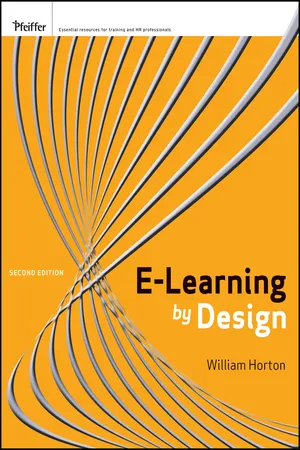
- English
- ePUB (mobile friendly)
- Available on iOS & Android
e-Learning by Design
About this book
Since the first edition of E-learning by Design, e-learning has evolved rapidly and fringe techniques have moved into the mainstream. Underlying and underwriting these changes in e–learning are advances in technology and changes in society.
The second edition of the bestselling book E-Learning by Design offers a comprehensive look at the concepts and processes of developing, creating, and implementing a successful e-learning program. This practical, down-to-earth resource is filled with clear information and instruction without over simplification. The book helps instructors build customized e-learning programs from scratch—building on core principles of instructional design to: develop meaningful activities and lessons; create and administer online tests and assessments; design learning games and simulations; and implement an individualized program.
"Every newcomer to the field will find this edition indispensable, while professionals will find much needed contemporary information to manage the rapid changes happening in our field. Even if you own the first edition, buy this update as soon as possible."
— Michael W. Allen, CEO of Allen Interactions, Inc.; author, Michael Allen's e-Learning Library Series
"Covers the full range of options for presenting learning materials online—including designing useful topics, engaging activities, and reliable tests—and it takes into account the realities and issues of today's instructional designers, such as social learning and mobile learning."
— Saul Carliner, associate professor, Concordia University; author, The E-Learning Handbook
"Horton nails it! Perfectly timed, robust, and practical, this second edition of brings together the latest strategies for learning without losing its critical premise—technology enables e-learning, but great design makes it work."
— Marc J. Rosenberg, e-learning strategist; author, Beyond E-Learning
"An e-learning encyclopedia loaded with detailed guidelines and examples ranging from basic instructional design techniques to the latest applications in games, social media, and mobile-learning. An essential reference for anyone involved in e-learning design, development, or evaluation"
— Ruth Colvin Clark, author, e-Learning and the Science of Instruction
Frequently asked questions
- Essential is ideal for learners and professionals who enjoy exploring a wide range of subjects. Access the Essential Library with 800,000+ trusted titles and best-sellers across business, personal growth, and the humanities. Includes unlimited reading time and Standard Read Aloud voice.
- Complete: Perfect for advanced learners and researchers needing full, unrestricted access. Unlock 1.4M+ books across hundreds of subjects, including academic and specialized titles. The Complete Plan also includes advanced features like Premium Read Aloud and Research Assistant.
Please note we cannot support devices running on iOS 13 and Android 7 or earlier. Learn more about using the app.
Information






Table of contents
- Cover
- Title page
- Copyright page
- Preface
- Chapter 1: Designing e-learning
- Chapter 2: Absorb-type activities
- Chapter 3: Do-type activities
- Chapter 4: Connect-type activities
- Chapter 5: Tests
- Chapter 6: Topics
- Chapter 7: Games and simulations
- Chapter 8: Social learning
- Chapter 9: Mobile learning
- Chapter 10: Design for the virtual classroom
- Chapter 11: Conclusion
- Appendix: Essentialism
- Index